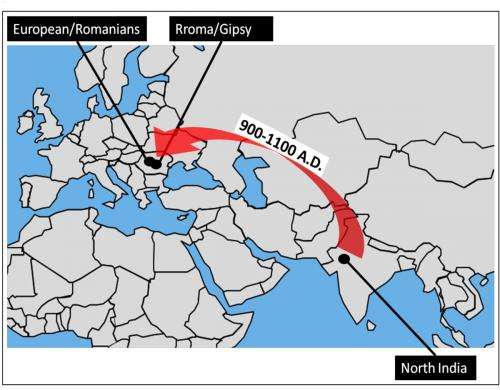February 4, 2014 report
Black Death may have caused convergent evolution in the immune systems of two distinct populations

(Medical Xpress)—Throughout human history, our immune systems have evolved in response to infectious diseases. People with genes that provide resistance to specific pathogens are more likely to survive infection and transmit those genes to future generations than people without these resistant genes. To gain a better understanding of how disease affects the evolution of our immune systems, Mihai Netea of Radboud University Nijmegen Medical Centre in the Netherlands and his colleagues studied two genetically distinct ethnic groups, European Romanians and Rroma, both of which lived in Romania during the time of the Black Death, or Black Plague. The researchers found that both groups harbor genes that provide resistance to the plague, and that these genes do not exist in populations from North India, the original home of the Rroma. This indicates that the immune systems of European Romanians and Rroma evolved convergently in response to the disease. The study appears in the Proceedings of the National Academy of Sciences.
The Rroma left North India and settled in Europe 1,000 years ago. By the 14th century, when the Black Death devastated Europe, both Rroma and European Romanians had established themselves in Romania. However, the two populations had not interbred much and therefore, their genomes remained distinct. Because of this, the researchers thought studying the two groups would provide valuable information about the evolution of genetic responses to disease. They hypothesized that the extreme evolutionary pressure caused by the plague would have led to convergent evolution in the immune systems of both populations.
To test their hypothesis, Netea and his colleagues studied the genomes of 100 Rroma, 100 people of European Romanian descent and 500 people of North Indian descent, whose ancestors had remained in India after the Rroma migration. The plague never affected India, so it would not have caused any changes to the immune systems of the North Indians.
After examining 200,000 single-nucleotide polymorphisms in all three groups, the scientists found that despite their different ancestries, the Rroma and the European Romanians shared 20 gene variants that the Northwest Indians did not possess. Among these shared gene variants was the gene cluster TLR2, which contains the genes TLR1, TLR6 and TLR10. These genes code for toll-like receptors, proteins that help defend against dangerous bacteria. When the researches exposed cells engineered to express TLR2 to the plague bacterium, Yersinia pestis, and to its ancestor, Yersinia pseudotuberculosis, the cells exhibited a heightened immune response.
The researchers think genetic adaptations caused by exposure to diseases earlier in history could have caused autoimmune diseases in modern populations.
More information: Convergent evolution in European and Rroma populations reveals pressure exerted by plague on Toll-like receptors, Hafid Laayouni, PNAS, DOI: 10.1073/pnas.1317723111
Abstract
Recent historical periods in Europe have been characterized by severe epidemic events such as plague, smallpox, or influenza that shaped the immune system of modern populations. This study aims to identify signals of convergent evolution of the immune system, based on the peculiar demographic history in which two populations with different genetic ancestry, Europeans and Rroma (Gypsies), have lived in the same geographic area and have been exposed to similar environments, including infections, during the last millennium. We identified several genes under evolutionary pressure in European/Romanian and Rroma/Gipsy populations, but not in a Northwest Indian population, the geographic origin of the Rroma. Genes in the immune system were highly represented among those under strong evolutionary pressures in Europeans, and infections are likely to have played an important role. For example, Toll-like receptor 1 (TLR1)/TLR6/TLR10 gene cluster showed a strong signal of adaptive selection. Their gene products are functional receptors for Yersinia pestis, the agent of plague, as shown by overexpression studies showing induction of proinflammatory cytokines such as TNF, IL-1β, and IL-6 as one possible infection that may have exerted evolutionary pressures. Immunogenetic analysis showed that TLR1, TLR6, and TLR10 single-nucleotide polymorphisms modulate Y. pestis–induced cytokine responses. Other infections may also have played an important role. Thus, reconstruction of evolutionary history of European populations has identified several immune pathways, among them TLR1/TLR6/TLR10, as being shaped by convergent evolution in two human populations with different origins under the same infectious environment.
© 2014 Medical Xpress















